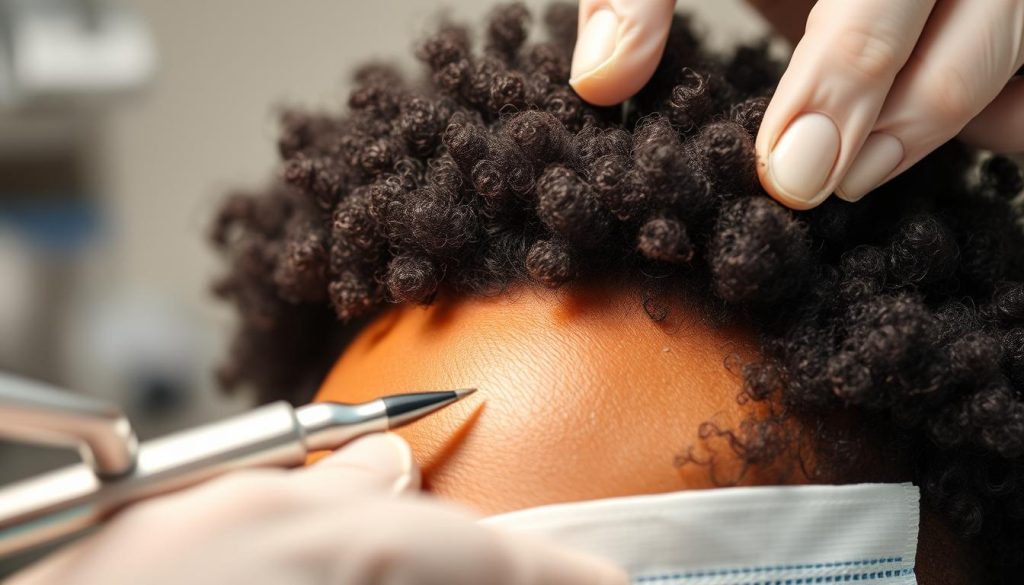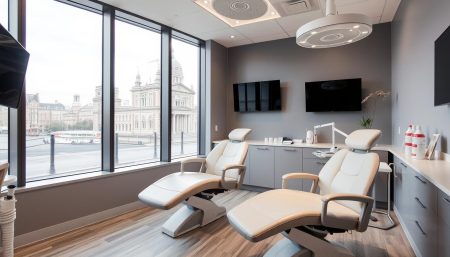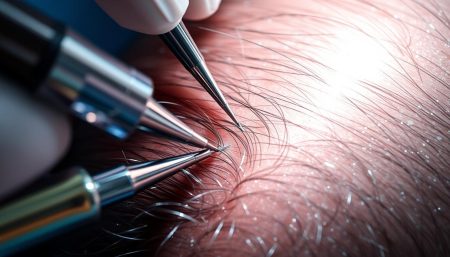Afro hair restoration has made big strides. The FUE afro hair transplant technique now offers hope to those with thinning or balding African American hair. It tackles the unique challenges of curly, coiled hair textures.
FUE, or Follicular Unit Extraction, works wonders for black hair. It creates natural-looking results by carefully moving individual hair follicles. This process keeps the curl pattern intact, giving a seamless blend with existing hair.
The fue afro hair transplant procedure is gaining popularity. It’s a game-changer for those seeking to restore their hairline and boost confidence. Let’s dive into the details of this revolutionary technique for afro-textured hair.
Understanding FUE Afro Hair Transplant Fundamentals
FUE afro hair transplant techniques have changed hair restoration for Black patients. This new method works well with African American hair, giving natural-looking results.
What Makes African American Hair Unique
African American hair is special because of its tight curls and oval-shaped follicles. These traits need special hair transplant surgery methods for the best results.
The Science Behind FUE for Curly Hair Textures
FUE uses advanced tools to take out and put in individual follicles. This careful method lets surgeons keep the hair’s natural curl, texture, and look.
Benefits of FUE for Black Patients
FUE has many benefits for African American patients looking for hair restoration:
| Benefit | Description |
|---|---|
| Natural Results | Keeps the original hair texture and curl pattern |
| Minimal Scarring | Creates no linear scars, perfect for short hairstyles |
| Faster Recovery | Is less invasive with a quicker healing time |
| Versatility | Works for different hair loss patterns and degrees |
Knowing these basics helps patients choose the right afro hair transplant surgery. This leads to better results.
The Evolution of Afro Hair Transplant Techniques
Afro hair restoration has made huge strides over the years. In the beginning, many specialists found it hard to get natural results. This was because African American hair is different.
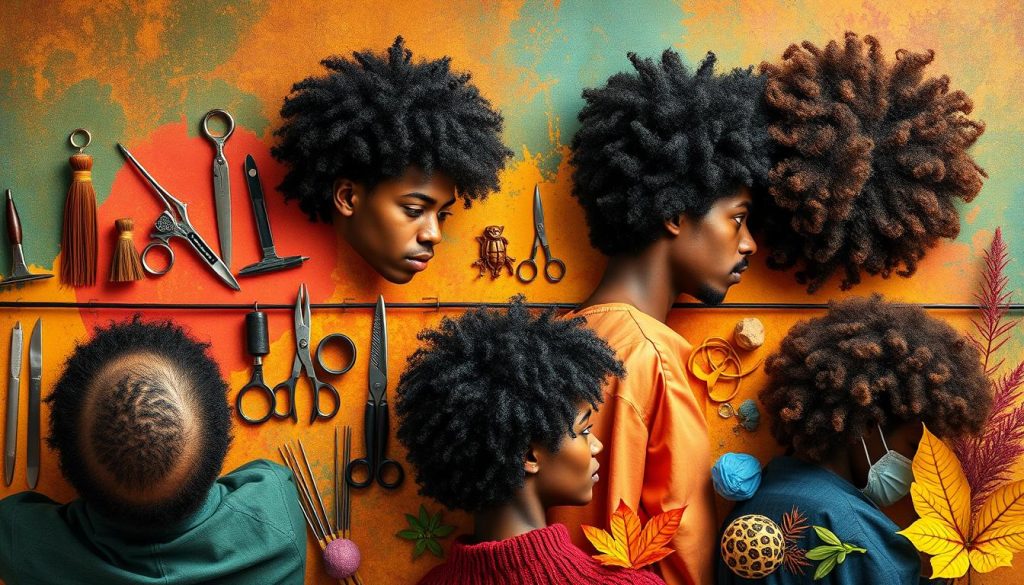
The 1990s were a big change. Surgeons learned to keep curl patterns and adapt for Black patients. They created special tools and methods for Afro-textured hair.
With new tech, hair transplants got more precise. Follicular Unit Extraction (FUE) changed the game. It gave better results and less scarring. This was great for African Americans, fitting their hair and growth better.
“The evolution of afro hair transplant techniques has been nothing short of remarkable. We can now achieve results that were once thought impossible,” says Dr. Lisa Johnson, a renowned afro hair transplant specialist.
Now, we have robotic hair transplants and digital imaging. These tools help specialists make plans just for each patient. This leads to more natural and happy results.
Special Considerations for Black Hair Restoration
Black hair restoration needs special care because of its unique traits. An afro hair transplant specialist must focus on several key points for natural-looking results. Let’s look at the main aspects of this special procedure.
Curl Pattern Preservation Methods
Keeping the natural curl pattern is vital in afro hair transplants. Skilled surgeons use special techniques to make sure the new hair looks like it belongs. They carefully place follicles to match the original curl direction and tightness.
Scalp and Follicle Characteristics
African American scalps have unique features that affect transplant success. The skin is thicker, and follicles curve. These traits need special tools and methods during the transplant. Surgeons must adjust their approach to work with these differences.
Hair Density Requirements
Getting the right hair density is key for a natural look. Black hair has lower density but looks fuller because of its texture. An experienced afro hair transplant specialist will plan graft distribution carefully. This creates a balanced, authentic look that fits the patient’s face and hair pattern.
“Understanding the unique qualities of African American hair is key to successful transplantation. Each patient requires a tailored approach for optimal results.”
By focusing on these special needs, skilled surgeons can give Black patients great hair restoration results. The afro hair transplant technique keeps getting better, leading to more natural and lasting results.
Step-by-Step FUE Procedure for African American Hair
The fue afro hair transplant process is a special procedure for African American hair. It needs a lot of skill to handle curly, coarse hair follicles.
The afro hair transplant surgery starts with a detailed consultation. Your surgeon will look at your hair loss, talk about what you want, and make a plan just for you.
On the day of the surgery, the area where the donor hair comes from is shaved. You’ll get local anesthesia to stay comfortable. Then, using special micro-punches, each follicle is taken out carefully, keeping the natural curl.
After that, tiny spots are made in the balding areas. The grafts are then placed in these spots, making sure they look natural. This is key for a good result.
| Step | Description | Duration |
|---|---|---|
| Consultation | Assessment and planning | 1-2 hours |
| Preparation | Shaving and anesthesia | 30-45 minutes |
| Extraction | Harvesting follicles | 2-4 hours |
| Implantation | Placing grafts | 2-4 hours |
| Post-op care | Instructions and follow-up | 30-60 minutes |
The whole fue afro hair transplant takes 6-8 hours, depending on how many grafts you need. After it’s done, you’ll get clear instructions on how to care for your new hair. This helps it grow well.
Advanced Technology in Afro Hair Transplant Surgery
Afro hair transplant techniques have evolved a lot. Today, top clinics use the latest tools for amazing results. Let’s explore some of the newest tech in afro hair transplant surgery.
Latest Tools and Equipment
Modern afro hair transplant clinics use special micro-punches. These tiny tools help surgeons remove curly hair follicles safely. The punches come in different sizes for various hair types.
Digital Hair Planning Systems
Computer software has revolutionized afro hair transplants. These systems create 3D models of a patient’s head. Doctors can then plan exactly where to place each hair graft.
This leads to fuller, more realistic hairlines for African American patients.
Precision Extraction Methods
New extraction methods make afro hair transplants more effective. One key technique is called “scoring.” This involves making a tiny cut around each follicle before removal.
It helps keep curly hairs intact during extraction. The result? More successful grafts and better outcomes for patients.
These advances in afro hair transplant techniques mean better results for Black patients. With the right clinic and tools, natural-looking hair restoration is now possible for many people.
Choosing the Right Afro Hair Transplant Specialist
Finding the right afro hair transplant specialist is key for natural-looking results. Start by looking into clinics known for African American hair treatments. Check out before-and-after photos of patients with hair like yours.
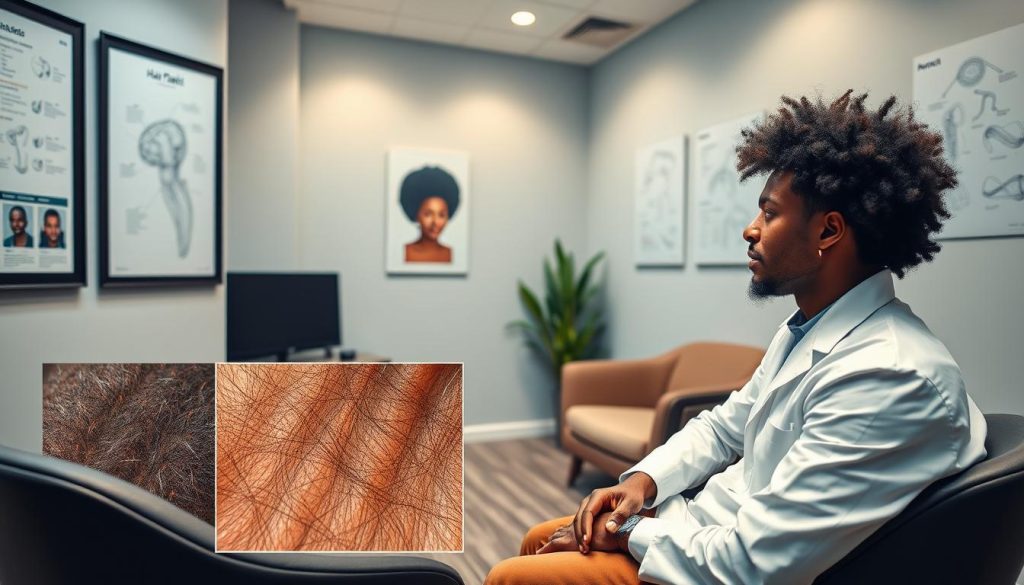
When you visit a clinic, ask about their experience with curly hair. A good specialist will talk about how they keep curls intact and handle Black hair challenges. Ask about their success rates and possible complications too.
Look at the technology the clinic uses. New tools can greatly improve your transplant’s outcome. Hair restoration technology has advanced, helping all hair types.
“The right specialist understands the unique needs of afro-textured hair and has the skills to create natural-looking results.”
Trust your gut feeling. Pick a specialist who makes you feel at ease and answers all your questions. This is a big step for your looks and confidence, so take your time.
Cost Analysis of FUE Hair Restoration for Black Hair
Understanding the cost of a fue afro hair transplant is key for those thinking about it. The price changes based on several factors unique to Black hair restoration.
Pricing Factors
The cost of a fue afro hair transplant depends on a few things. These include the number of grafts needed, the surgeon’s expertise, and where the clinic is. Black hair’s texture often needs more skill and time, which can make the price go up.
| Factor | Impact on Cost |
|---|---|
| Number of Grafts | $3,000 – $15,000+ |
| Surgeon Experience | 10-30% premium |
| Clinic Location | 20-50% variation |
Insurance and Financing Options
Most insurance plans don’t cover hair transplants. But, many clinics offer financing plans to help. Some people choose medical tourism to save money.
Investment Value Assessment
The upfront cost of an afro hair transplant may seem high. But, many see it as a good investment. The long-term benefits of feeling confident and having natural-looking hair are worth the cost for those dealing with hair loss.
“My fue afro hair transplant was life-changing. The cost was significant, but the results were priceless.”
In the end, deciding on a fue afro hair transplant should weigh the cost against the quality-of-life benefits.
Recovery Timeline and Post-Procedure Care
Afro hair transplant recovery needs careful attention for the best results. The healing process takes time, with noticeable improvements over weeks. Patients usually feel little pain in the first days after surgery.
In the first week, tiny scabs form around the transplanted follicles. These scabs fall off, showing new hair growth. By week two, most signs of the procedure disappear. Full results show after several months as the new hair grows naturally.

Proper care is key for healing. Gently clean the scalp to prevent infection. Avoid direct sunlight and hard activities for a few weeks. Following the surgeon’s advice helps heal well and boosts the chance of good results.
“Patience is key during afro hair transplant recovery. Trust the process and follow post-operative care guidelines diligently for the best results.”
| Recovery Stage | Timeline | Care Instructions |
|---|---|---|
| Immediate Post-Op | 1-3 days | Rest, avoid touching grafts |
| Early Healing | 4-14 days | Gentle washing, avoid sun exposure |
| Settling Phase | 2-8 weeks | Resume normal activities, protect scalp |
| Growth Phase | 3-6 months | Maintain healthy hair care routine |
Natural Hairline Design for African American Patients
Creating a natural hairline is key in afro hair restoration. The technique must respect cultural preferences and offer personalized options. This ensures patients get the look they want with confidence.
Cultural Considerations
African American hair has unique traits that shape hairline design. Surgeons skilled in afro hair transplants grasp these characteristics. They consider hair texture, growth patterns, and facial features.
This knowledge helps create hairlines that look authentic. They complement each patient’s appearance perfectly.
Customization Options
Patients have many choices in designing their new hairline. Some like a straighter edge, while others prefer a textured look. The density and position of transplanted hair can be tailored to fit personal style.
Skilled surgeons work with patients to create a hairline that suits their face shape. This enhances their features.
“A well-designed hairline should look so natural that no one can tell you’ve had a transplant.”
Advanced afro hair restoration techniques allow for precise placement of individual follicles. This ensures a seamless blend with existing hair. The result is a hairline that appears completely natural.
This boosts the patient’s self-esteem and satisfaction with their new look.
Managing Expectations: Before and After Results
It’s important to have realistic hopes for afro hair transplant results. People often dream of perfect outcomes, but results can vary. Looking at before and after photos can help, but they don’t show everything.
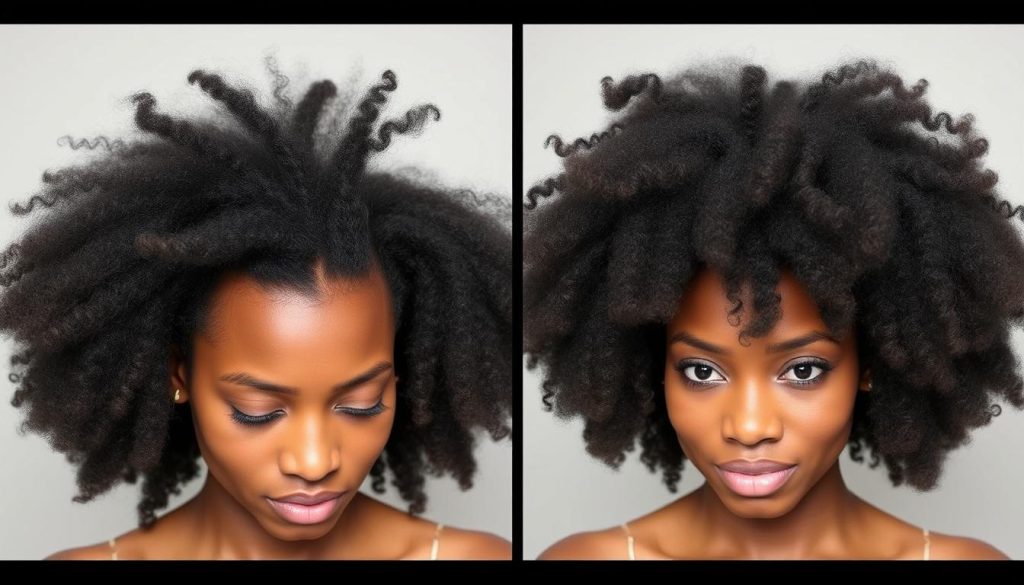
Visible growth starts about 3-4 months after the procedure. It takes 12-18 months to see full results. During this time, the new hair will go through cycles of growth, shedding, and regrowth.
Hair density is a big factor in how well the transplant works. Surgeons try to make it look natural, but it’s not always possible. Those with a lot of hair loss might need more than one session to get the look they want.
“Patience is key when it comes to afro hair transplants. The journey to your final results is gradual, but the wait is worth it for most patients.”
Scalp condition, overall health, and following post-op care can affect results. It’s key to have realistic hopes and talk openly with your surgeon. This helps ensure you’re happy with your new hairline.
Potential Challenges and Solutions in Afro Hair Transplants
Afro hair transplant surgery faces unique challenges because of African American hair’s special traits. Knowing these challenges helps both patients and specialists handle the process better.
Common Complications
Complications can happen during afro hair transplant surgery. These include folliculitis, keloid scarring, and uneven hair growth. The curved shape of African American hair follicles makes it harder to extract them, raising the risk of damage.
Prevention Strategies
Specialists use advanced methods to lower risks. They use special tools for curved follicles and plan surgeries carefully. Teaching patients how to care for their hair after surgery is also key.
Treatment Solutions
If problems do occur, acting quickly is important. Treatments might include antibiotics for folliculitis, steroid shots for keloid scarring, and treatments to help hair grow evenly. Regular check-ups with a specialist help catch and treat issues early.
| Complication | Prevention | Treatment |
|---|---|---|
| Folliculitis | Sterile technique, proper aftercare | Topical antibiotics, warm compresses |
| Keloid Scarring | Minimally invasive techniques | Steroid injections, laser therapy |
| Uneven Growth | Precise graft placement | Growth stimulation treatments |
By tackling these challenges, afro hair transplant surgery can give patients the natural-looking results they want.
Long-term Maintenance of Transplanted Afro Hair
Keeping your afro hair transplant looking great takes work and care. A successful hair restoration journey doesn’t stop after the procedure. It’s important to follow a special care routine to keep your hair healthy and looking good.
Begin by using gentle, sulfate-free shampoos and conditioners made for textured hair. These products keep your hair moist and prevent it from breaking. Doing a deep conditioning treatment once a week can make your hair more elastic and shiny.

Use a silk or satin pillowcase to protect your hair while you sleep. This reduces hair friction and keeps it moist. For styling, use wide-toothed combs and avoid tight hairstyles that can harm your hair follicles.
“Regular trims every 8-12 weeks help maintain the shape and health of your transplanted afro hair, ensuring long-lasting results.”
What you eat is also key to your hair’s health. Eating foods rich in proteins, vitamins, and minerals helps your hair grow strong. If your doctor suggests it, taking biotin or vitamin D supplements can also help.
| Maintenance Aspect | Recommended Frequency | Benefits |
|---|---|---|
| Washing | 1-2 times per week | Keeps scalp clean, prevents buildup |
| Deep Conditioning | Once a week | Improves moisture retention, reduces breakage |
| Trimming | Every 8-12 weeks | Maintains shape, removes split ends |
| Scalp Massage | 2-3 times per week | Stimulates blood flow, promotes growth |
By sticking to these maintenance tips, you’ll keep your afro hair transplant looking great for years. Enjoy a full, healthy head of hair for a long time.
Combining FUE with Other Hair Loss Treatments
FUE afro hair transplant procedures can be made better with other treatments. This mix offers a full solution for African American patients wanting to restore their hair. It boosts confidence too. Let’s look at some ways to enhance your afro hair restoration journey.
Complementary Therapies
Many patients see great results by adding non-surgical therapies to their FUE transplant. Low-level laser therapy (LLLT) can help hair grow and improve scalp health. Platelet-rich plasma (PRP) treatments use your body’s growth factors to promote hair growth. These can make your FUE afro hair transplant even better.
Medication Options
Prescription meds are key for keeping transplanted hair healthy and stopping more loss. Finasteride and minoxidil are FDA-approved and work well for many African American patients. They strengthen hair and encourage new growth. Your doctor might suggest a hybrid hair restoration plan, mixing meds with your FUE for the best results.
Adding these treatments to your afro hair restoration plan can lead to fuller, more natural-looking hair. Always talk to your hair transplant specialist. They can help create a plan that meets your specific needs and goals.
FAQ
Q: What makes FUE hair transplants suitable for Afro-textured hair?
A: FUE hair transplants work well for Afro-textured hair. They match the unique curl pattern and follicle structure. This technique allows for precise placement of individual hair follicles, ensuring a natural look.
Q: How long does an FUE Afro hair transplant procedure typically take?
A: The time needed for an FUE Afro hair transplant varies. It depends on the extent of hair loss and grafts needed. It usually takes 4 to 8 hours. Larger cases might need more sessions.
Q: What is the average cost of an Afro hair transplant?
A: The cost of an Afro hair transplant varies. It depends on the surgeon’s expertise, clinic location, and grafts needed. Prices range from ,000 to ,000 or more. Get a personalized quote from a specialist.
Q: How long does it take to see results after an Afro hair transplant?
A: You might see results in 3 to 4 months. But, it takes 12 to 18 months for full results. This is when the transplanted hair grows and matures.
Q: Are there any special considerations for maintaining transplanted Afro hair?
A: Yes, special care is needed for transplanted Afro hair. Use gentle, sulfate-free shampoos and moisturize often. Avoid tight hairstyles and protect your hair while sleeping with satin or silk.
Q: Can women with Afro-textured hair undergo FUE hair transplants?
A: Absolutely! Women with Afro-textured hair can benefit from FUE hair transplants. The procedure can be customized to address female hair loss patterns, achieving natural results.
Q: How do I choose the right specialist for my Afro hair transplant?
A: Choose a specialist with experience in African American hair. Look at their portfolio, read reviews, and ensure they use the latest techniques. Ask about their success with Afro-textured hair.
Q: What is the recovery process like after an Afro hair transplant?
A: Recovery is usually easy. Most can go back to work in 3 to 5 days. The area may be sensitive for weeks. Follow care instructions for full healing in 10 to 14 days.
Q: Can FUE be combined with other hair loss treatments for better results?
A: Yes, FUE can be combined with other treatments. This might include medications or PRP therapy. Your specialist can suggest the best combination for you.
Q: What are the possible complications of Afro hair transplant surgery?
A: Complications are rare with an experienced surgeon. Risks include infection, scarring, or unnatural results. Choosing a qualified surgeon and following care instructions can reduce these risks.












